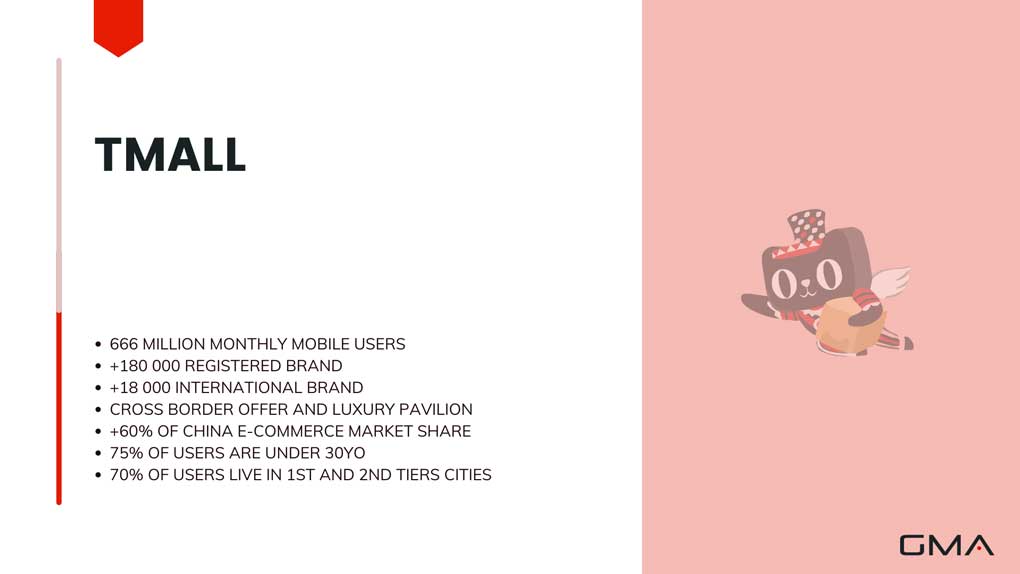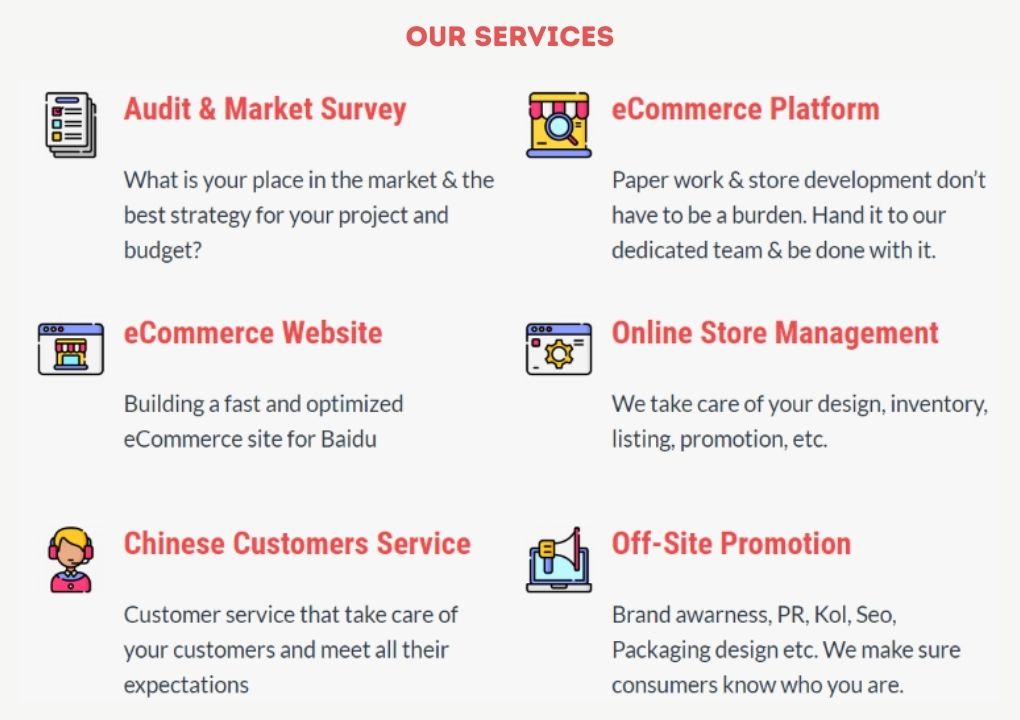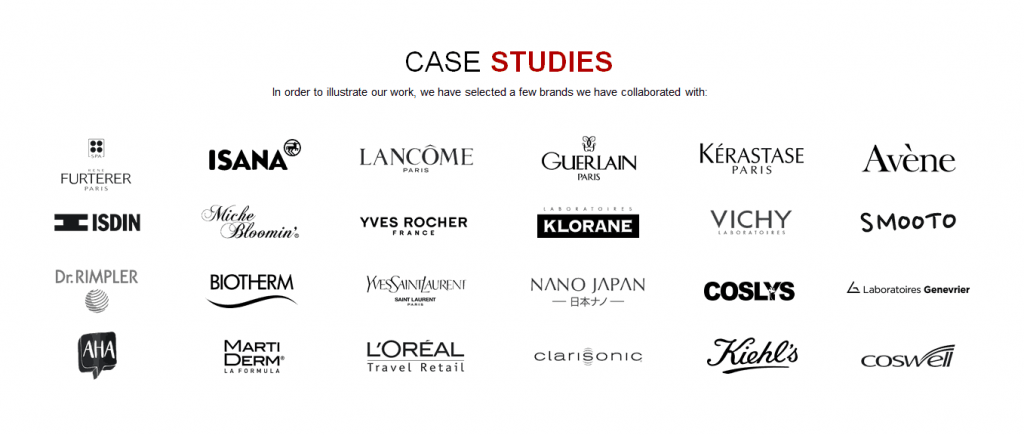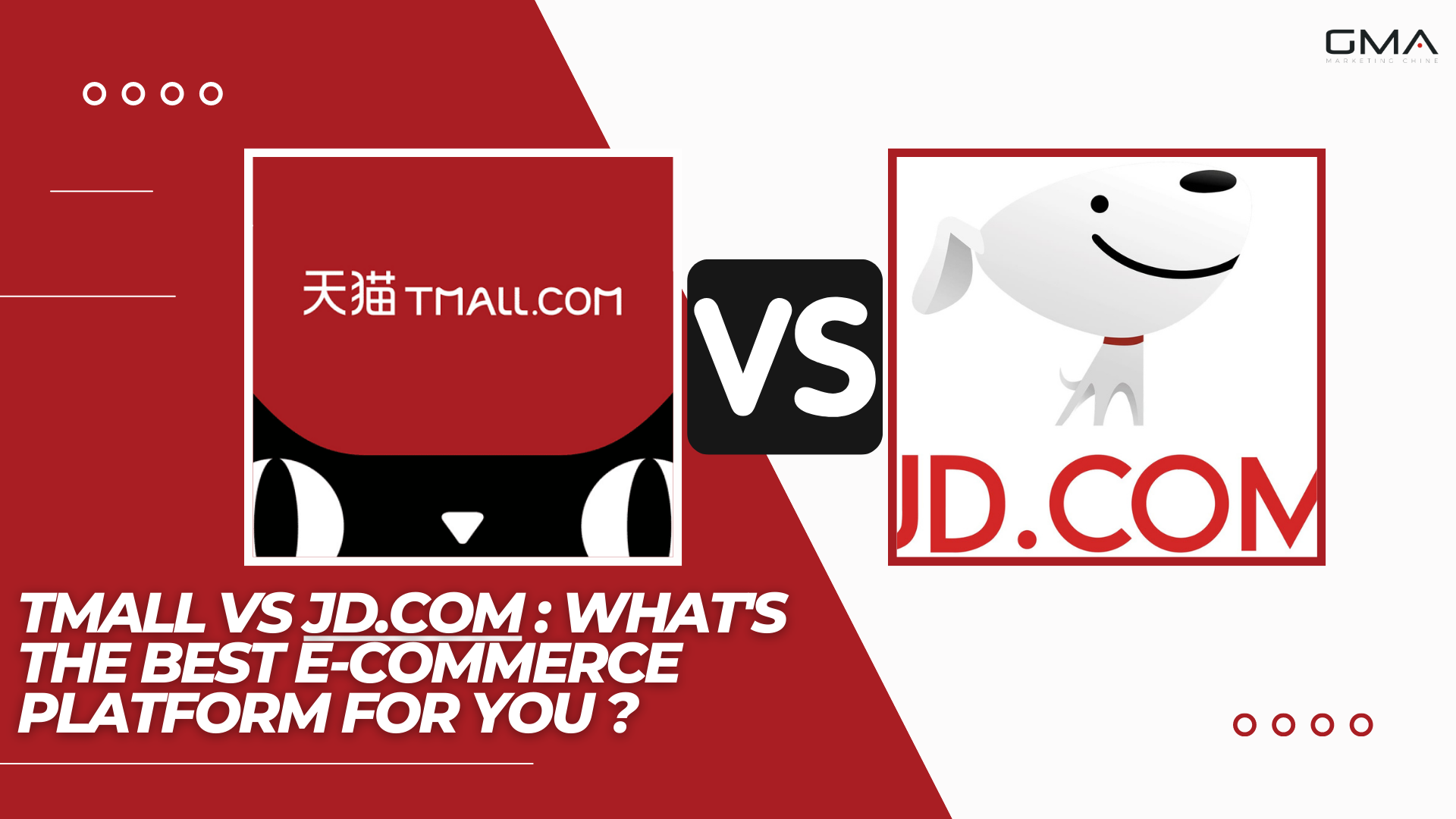Choosing an online store between Tmall and JD.com for your e-commerce needs can be overwhelming.
This blog post is a culmination of that investigation, aimed at helping you distinguish between Tmall and JD.com in terms of their specialties, business models, audience demographics, advantages, and drawbacks.
Need a cost effective TP (Tmall Partner) to sell in China?
We are an Official Tmall Partner e-commerce Agency. Our Services: E-Commerce, Search Engine Optimization, Advertising, Weibo, WeChat, WeChat Store & PR.
So let’s delve into unraveling these giants of China’s booming e-commerce market!
Key Takeaways
- Tmall and JD.com are prominent e-commerce platforms in China, with Tmall focusing on luxury brands and JD.com expanding its reach in the luxury e-commerce industry.
- Tmall caters to broader market needs with a wide range of products, while JD.com focuses on technology-related products and high-end fashion.
- Tmall operates as a marketplace platform where brands can set up their own online storefronts, while JD.com acts more like a traditional retailer owning inventory and operating its own warehouses.
- Both platforms offer partnership opportunities and support for foreign businesses entering the Chinese market, with dedicated resources for logistics, marketing, and customer engagement.
Overview of Tmall and JD. com
In 2008, Alibaba Group launched Tmall as a platform for B2C transactions, offering branded goods to Chinese customers. It is known for being a trustworthy platform connecting buyers and sellers.
On the other hand, JD.com started in 2004 with a self-operated model, aiming to gain customer trust by controlling the entire purchase, storage, and delivery processes.
Both platforms have been continuously improving their technology while competing for dominance in the e-commerce market.

Current market position and influence
Tmall is a prominent player in China’s e-commerce landscape and holds a strong market position. It is ranked 4th in the marketplace category and is a key part of Alibaba’s e-commerce duo, along with Taobao. Tmall offers a wide range of products to cater to diverse market needs.

On the other hand, JD.com takes a different approach by focusing on technology and quality assurance through its closed business model.
This strategy has helped JD.com secure over 200 places in traffic rankings, making it one of the top contenders in online retailing. JD.com’s commitment to product quality and technological expertise has solidified its influence in China’s booming e-commerce industry.

Key Differences Between Tmall and JD. com
Tmall and JD.com have distinct differences in their target audience, product categories, business models, logistics systems, traffic, and engagement, as well as partnerships and support for foreign businesses.
Target audience and market focus
Tmall and JD.com are both major players in the e-commerce industry, but they have different target audiences and market focuses.

Tmall primarily focuses on clothing, cosmetics, and other consumer goods, making it a popular choice for businesses targeting female consumers or those interested in fashion-forward products.
On the other hand, JD.com is known for its dominance in technology-related products, attracting tech-savvy individuals and catering to niche markets. Despite competition in the luxury sector, Tmall remains a top choice for cosmetic brands.
Product categories and specialties
Tmall and JD.com have distinct product categories and specialties that differentiate them from each other. Tmall focuses on clothing and cosmetics, offering a wide range of fashion choices and beauty products.
On the other hand, JD.com specializes in technology and high-end fashion, making it the preferred platform for consumers looking for the latest gadgets or luxury brands. Both platforms also target different demographics, with Tmall appealing more to younger shoppers and JD.com attracting a slightly older audience.

When deciding which platform is best for your brand or product, it is important to consider factors such as target audience preferences and industry specialization to maximize success in China’s competitive e-commerce market.
Business models and logistics system
Tmall and JD.com are two e-commerce platforms with distinct differences in their business models and logistics systems.
Tmall operates as a marketplace where brands and merchants can set up their own online storefronts, giving them more control over their branding and customer experience. Tmall also has its own logistics system with warehouses and distribution centers, ensuring efficient delivery for sellers.
On the other hand, JD.com operates more like a traditional retailer, owning inventory and operating its own warehouses and distribution centers. This means that businesses selling on JD.com may have less control over their branding but can benefit from JD.com’s reliable logistics network.
Both platforms also offer cross-border options for foreign businesses looking to sell directly to Chinese consumers. Tmall Global serves as the cross-border platform of Tmall, while JD Worldwide is JD.com’s cross-border platform.
Traffic and engagement
In terms of traffic and engagement, Tmall and JD.com have different strengths. Tmall.com is highly popular among consumers and is ranked #4 in the Marketplace category for traffic. JD.com may not have as high of a ranking at #204, but it still attracts a significant number of visitors.
However, when it comes to the luxury sector, both platforms have similar levels of traffic and engagement.
Therefore, it is important to consider your target audience and product offerings to determine which platform aligns best with your brand strategy.
Partnership and support for foreign businesses
Both Tmall and JD.com offer great partnership opportunities and support for foreign businesses. They recognize the importance of international brands in the Chinese market and provide dedicated resources to ensure their success.
Tmall has Tmall Global, a cross-border platform, while JD.com also offers a platform for cross-border selling. These platforms have partnerships with renowned luxury brands and offer assistance with logistics, marketing, and customer engagement.

Pros and Cons of Selling on Tmall and JD. com
Pros and cons of selling on Tmall and JD.com vary, with Tmall offering a vast user base and popularity in clothing, cosmetics, and F&B purchases while JD.com is preferred for home purchases due to its focus on technology.
Advantages of selling on Tmall
Selling on Tmall offers several advantages for businesses looking to enter the Chinese e-commerce market. Here are some key benefits:
- Access to a wide customer base: Tmall has a massive user base, allowing businesses to tap into a large pool of potential customers in China.
- Brand reputation and trust: Tmall is known for its strict regulations and authentication processes, which adds credibility and trustworthiness to brands selling on the platform. This can help build brand reputation and attract loyal customers.
- High traffic and exposure: Tmall attracts millions of daily visitors, providing high visibility for brands and increasing the chances of reaching a larger audience.
- Integrated marketing solutions: Tmall provides various marketing tools and support services, such as targeted advertising, promotional campaigns, and access to consumer insights. These resources can help businesses effectively market their products and reach their target audience.
- Seamless logistics system: Tmall has an efficient logistics network in place, ensuring smooth order fulfillment, delivery, and returns management. This can result in better customer satisfaction and retention.
- Opportunities for cross-border trade: With its cross-border platform, Tmall Global, foreign businesses can easily sell their products to Chinese consumers without complicated regulatory processes or setting up physical stores in China.
- Ongoing support and guidance: Tmall offers support services to help businesses navigate the platform effectively, including assistance with store setup, account management, and troubleshooting.
- Enhanced product visibility: Tmall provides various tools for product presentation, such as detailed product descriptions, images, videos, and customer reviews. This allows businesses to showcase their products effectively and engage potential customers.
- Integration with Alibaba’s ecosystem: As part of Alibaba Group’s ecosystem, selling on Tmall opens up opportunities for collaboration with other Alibaba platforms like Taobao or Alipay for additional reach and growth potential.
- Direct communication with customers: Tmall allows businesses to communicate directly with customers through its messaging system, enabling personalized customer service and building strong customer relationships.
Disadvantages of selling on Tmall
Selling on Tmall, while it has its benefits, also comes with some disadvantages that should be considered. Here are a few key disadvantages to keep in mind:
- Higher entry barriers: Getting started on Tmall can be more challenging compared to other platforms. There are stricter requirements and qualifications that need to be met before being accepted as a vendor.
- Increased competition: Tmall is a popular platform with a large number of sellers, which means the competition can be fierce. This makes it harder for new brands to stand out and attract customers.
- Limited control over branding and customer experience: When selling on Tmall, brands have less control over their online store’s appearance and customization options compared to having their own independent website. This can limit the ability to create a unique brand identity and provide a tailored customer experience.
- Cost implications: Selling on Tmall comes with certain costs, including annual fees, commission fees, and marketing expenses to promote products within the platform. These costs can add up and impact profit margins.
- Difficulty in building direct customer relationships: On Tmall, the emphasis is on transactions rather than building direct relationships with customers. This can make it challenging for brands to gather customer data or directly engage with their target audience.
- Complex logistics and fulfillment: Managing logistics and order fulfillment on Tmall can be complex due to the large volume of orders and varying delivery requirements across different regions in China.

Advantages of selling on JD.com
Selling on JD.com offers several advantages for businesses looking to expand their presence in the Chinese e-commerce market. Here are the key advantages of selling on JD.com:
- Access to a large customer base: JD.com is one of the largest e-commerce platforms in China, with a vast customer base of millions of active buyers. This provides businesses with a great opportunity to reach a wide audience and increase their sales potential.
- Strong focus on authenticity: JD.com places a strong emphasis on product authenticity and quality control. This gives brands selling on the platform an advantage, as it helps build trust and credibility among Chinese consumers who value genuine products.
- Comprehensive logistics system: JD.com has developed an extensive logistics network, ensuring fast and reliable delivery services across China. This allows businesses to offer efficient shipping options to customers, which can greatly enhance the overall shopping experience.
- Enhanced marketing and promotional tools: JD.com provides various marketing tools and resources to help brands boost their visibility and attract customers. These include banner ads, targeted promotions, social media campaigns, and more, giving businesses the opportunity to effectively promote their products.
- Extensive data analytics: JD.com offers robust data analytics tools that provide valuable insights into consumer behavior and preferences. This enables businesses to make informed decisions regarding pricing strategies, product offerings, and marketing campaigns.
- Partnership opportunities: JD.com actively collaborates with international brands and offers partnership programs that can help companies expand their presence in China’s market. These partnerships often involve cross-promotion initiatives and increased brand exposure.
- Integration with offline retail stores: In addition to its online marketplace, JD.com also has a network of physical retail stores known as “JD Retail Experience Shops.” These shops allow brands to showcase their products in-store while leveraging the benefits of online sales through JD.com’s platform.
- Trusted reputation: JD.com has built a strong reputation for customer service excellence, which contributes to increased consumer trust and loyalty. Selling on JD.com can help businesses align with this trusted reputation, which is vital for success in the competitive Chinese market.
Disadvantages of selling on JD.com
Selling on JD.com has its own set of disadvantages that marketers should consider. Here are some key points to keep in mind:
- Limited product categories: Unlike Tmall, which offers a wide range of product categories and specialties, JD.com primarily focuses on electronics and appliances. This can be a disadvantage for businesses that sell products outside of these categories.
- Higher entry costs: Setting up a store on JD.com requires a higher initial investment compared to other e-commerce platforms. There are various fees involved, such as deposit fees, annual service fees, and commission fees. These costs can be challenging for small businesses or startups with limited budgets.
- Less traffic and engagement: While JD.com is a major player in the Chinese e-commerce market, it lags behind Tmall in terms of overall website traffic and user engagement. This means that sellers may have fewer opportunities to reach potential customers and generate sales compared to Tmall.
- Strong competition: Due to its popularity and market share, JD.com attracts many sellers, resulting in intense competition within the platform. It can be challenging for new or smaller businesses to stand out amidst the competition and gain visibility for their products.
Although JD Worldwide allows foreign businesses to sell directly to China, it may not provide as comprehensive support as Tmall Global does.
The process of registration and compliance can be more complex on JD.com, making it harder for international brands to enter the Chinese market.
Case Studies of Successful Foreign Brands on Tmall and JD. com
Tmall and JD.com are popular platforms for international businesses entering the Chinese market.
One case study involves Michael Kors, an American fashion brand, which used Tmall’s reach and logistics system to establish a strong presence in China. They utilized data-driven marketing tools to effectively target their audience and experienced significant growth in revenue and brand awareness.
Another example is IKEA, a Swedish furniture retailer, which found success on JD.com by offering affordable yet stylish home furnishings and utilizing JD.com’s reliable delivery system.

These examples highlight how Tmall and JD.com provide opportunities for foreign brands to tap into the vast Chinese market by understanding consumer preferences, utilizing innovative features, and leveraging data-driven strategies.

Strategies for Entry and Success on Tmall and JD. com
To ensure success when entering Tmall and JD.com, it is essential to carefully plan your entry strategy, focusing on steps such as launching your business on these platforms, implementing effective marketing strategies to attract customers, engaging with them through personalized interactions and feedback, and ensuring smooth delivery processes.
Steps to launch your business on these platforms
To successfully launch your business on Tmall or JD.com, there are a few important steps to keep in mind. Here’s a simple guide to help you get started:
Assess your product’s potential
Before diving into any Chinese e-commerce platform, it’s crucial to assess the potential success of your product in the market. Conduct thorough market research, analyze competitor products, and identify unique selling points.
Obtain a Chinese business license
To sell on JD.com or directly through Tmall, you’ll need a Chinese business license. This can be obtained by setting up a subsidiary company in China or partnering with a local agent who already has the necessary licenses.
Build a strong brand presence
Invest time and resources into building brand awareness before launching on these platforms. Establish an official website, create engaging content on social media platforms like WeChat and Weibo, and leverage influencers to generate buzz around your brand.

Optimize your product listings
Create compelling and informative product descriptions and images that highlight the unique features of your products. Use keywords relevant to your target audience to improve search rankings.
Ensure efficient logistics
Partner with reliable logistics providers to ensure smooth order fulfillment and timely delivery of products to customers. This will help build trust among consumers and encourage repeat purchases.
Strategies for marketing, customer engagement, and delivery
When it comes to marketing, customer engagement, and delivery on e-commerce platforms like Tmall and JD.com, there are several key strategies that can help businesses succeed. Here are some important tactics to consider:
Data-driven marketing
Utilize data analysis to understand consumer behavior, preferences, and shopping patterns. This will help tailor marketing campaigns and promotions to target specific customer segments effectively.
Customer engagement through personalized experiences
Implement personalized marketing approaches such as targeted ads, personalized recommendations, and customized product bundles. This will enhance the overall shopping experience and build stronger relationships with customers.
Seamless delivery services
Partner with reliable logistics providers or use fulfillment services provided by Tmall or JD.com to ensure fast and efficient delivery of products. Offering options like express shipping or free shipping thresholds can also attract more customers.
Leveraging social media platforms
Utilize popular Chinese social media platforms like WeChat or Weibo to engage with customers, promote products, and run promotional campaigns. These platforms have a massive user base in China and offer great potential for brand exposure.
Seasonal promotions
Take advantage of seasonal events like Singles’ Day (November 11th) or Chinese New Year to offer special promotions, discounts, or limited-edition products. These events attract a large number of shoppers looking for deals and can significantly boost sales.

Influencer marketing
Collaborate with popular influencers in China who have a strong following on social media platforms. They can help promote your products through reviews, unboxing videos, or sponsored posts, reaching a wider audience in an authentic way.
Consider using programmatic advertising tools available on Tmall and JD.com to target specific audience segments based on demographics or purchasing behavior. This can increase visibility and drive relevant traffic to your product listings.
Contact us to choose the best e-commerce platform for your business!
Tmall and JD.com are both prominent e-commerce platforms in China, with their own unique features and offerings. While Tmall is more focused on clothing, cosmetics, and F&B purchases, JD.com caters to home purchases and has a strong emphasis on technology.
It’s important for businesses to carefully consider their target audience and product categories when choosing the right platform. Overall, the future outlook for e-commerce trends in China looks promising, with continued growth expected in the online retail market.

We are a China-based marketing agency offering cost-effective solutions to foreign brands interested in tapping into the Chinese eCommerce market. Our team of Chinese and foreign experts has the experience and know-how needed to succeed in this lucrative, yet complicated market.
Gentlemen Marketing Agency offers many digital marketing and e-commerce solutions, such as web design, e-commerce and social media marketing strategies, localization, market research, KOL marketing, and more.

Don’t hesitate to leave us a comment or contact us, so that we can schedule a free consultation with one of our experts, that will learn about your brand and present you the best solutions for your China market strategy.









como faço para comprar os produtos da China, por um preço ascensível,e revender para o Brazil
Gostaria de comprar os produtos da China e vender para o Brazil